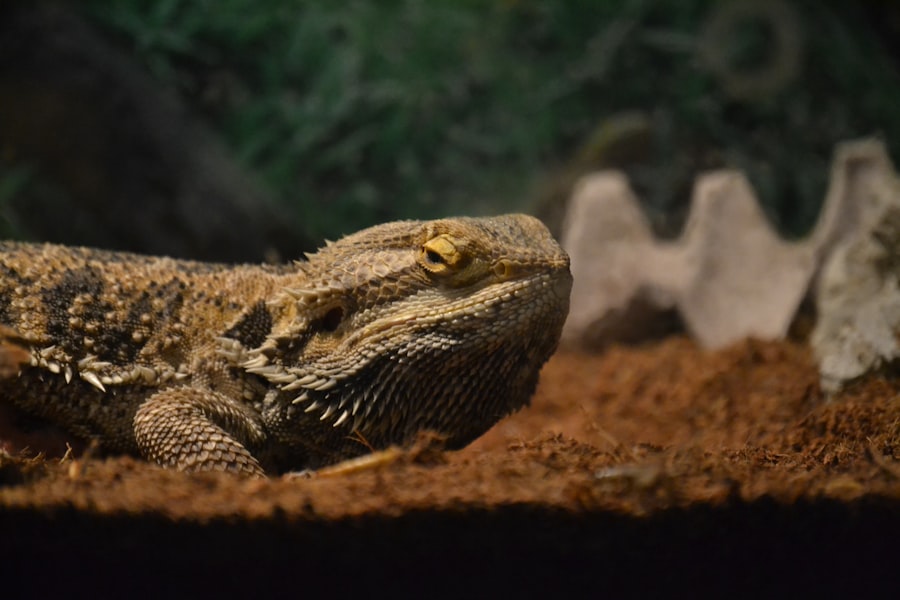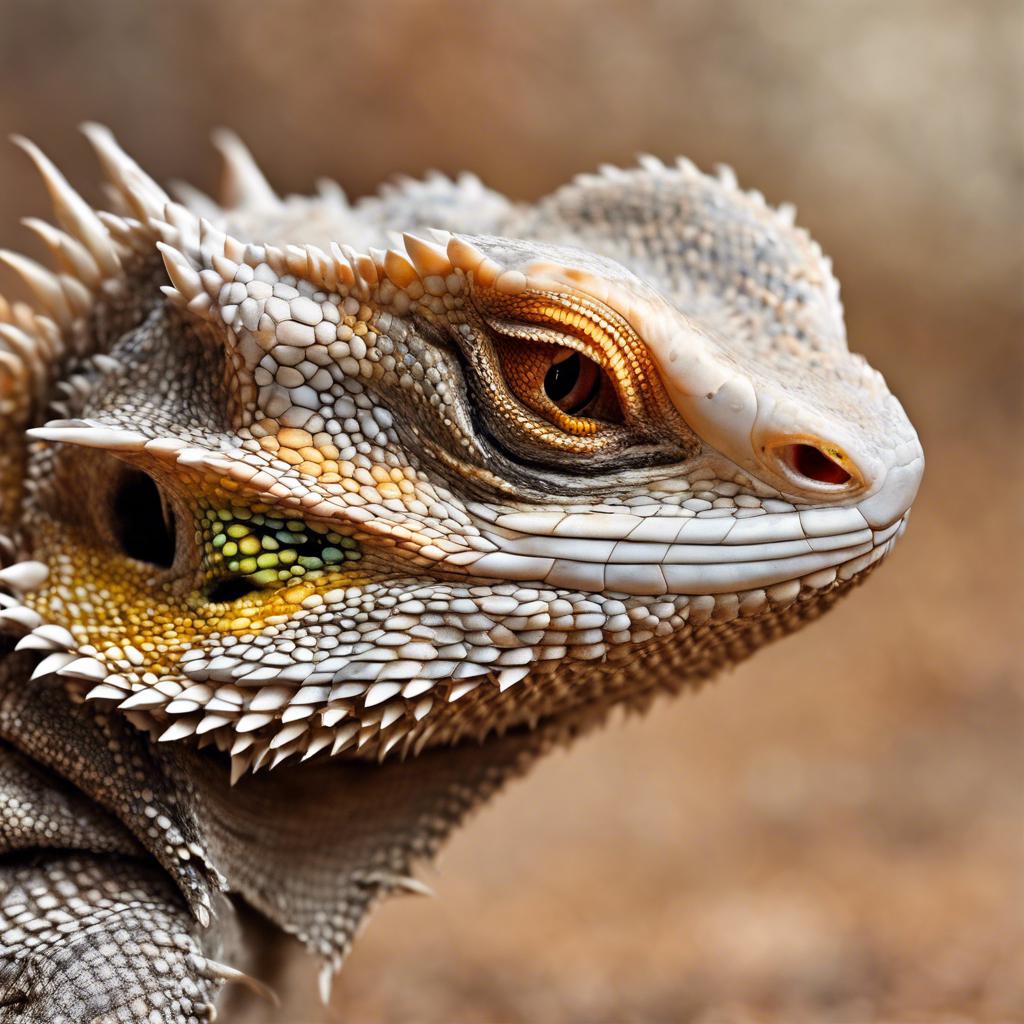Bearded dragons, scientifically known as Pogona, are a type of lizard native to Australia. They are named for the spiky beard-like scales on their throats that they puff out when they feel threatened or excited. Bearded dragons have become increasingly popular as pets due to their docile nature and unique appearance.
One of the reasons why bearded dragons make great pets is their calm and friendly temperament. They are known for being relatively easy to handle and can become quite tame with regular interaction. Additionally, they are not prone to biting or aggression, making them a suitable choice for families with children or first-time reptile owners.
Key Takeaways
- Bearded dragons are popular pets that require proper care and attention.
- Understanding the life cycle of a bearded dragon is important for their care.
- A 10-month-old bearded dragon has specific characteristics and needs.
- Setting up a suitable habitat with proper lighting and temperature is crucial for their health.
- Feeding, hygiene, and bonding are important aspects of caring for a bearded dragon.
Understanding the Life Cycle of a Bearded Dragon
Bearded dragons go through several stages in their life cycle. They start as eggs, which are laid by the female in a nest she digs in the ground. After an incubation period of around 60 days, the eggs hatch, and the baby bearded dragons emerge.
As they grow, bearded dragons go through various stages of development. At around 2 months old, they reach the juvenile stage, where they start to develop their adult colors and patterns. By 10 months old, they are considered sub-adults and have reached a significant size.
In terms of lifespan, bearded dragons can live up to 10-15 years with proper care. However, some individuals have been known to live even longer with exceptional care and genetics.
The Characteristics of a 10-Month-Old Bearded Dragon
At 10 months old, a bearded dragon is considered a sub-adult and has developed many of its adult characteristics. In terms of physical appearance, they have grown significantly in size compared to when they were hatchlings. They typically measure around 12-18 inches in length and have a robust build.
The coloration of a 10-month-old bearded dragon can vary depending on its genetics and environment. They may display vibrant colors such as orange, yellow, and red, with patterns and markings that help them blend into their surroundings.
In terms of behavior and temperament, 10-month-old bearded dragons are generally curious and active. They enjoy exploring their surroundings and may display playful behaviors such as chasing after insects or climbing on branches. However, they are also known for their calm and docile nature, making them easy to handle and interact with.
Setting Up a Suitable Habitat for Your Bearded Dragon
Creating a suitable habitat is crucial for the health and well-being of your bearded dragon. The size of the enclosure is an essential factor to consider. A 10-gallon tank is suitable for a baby bearded dragon, but as they grow, they will require a larger enclosure. A 40-gallon tank is recommended for a 10-month-old bearded dragon.
The substrate used in the enclosure should be safe and easy to clean. Options such as reptile carpet or ceramic tiles are ideal choices as they do not pose a risk of impaction if ingested. Avoid using loose substrates like sand or wood chips, as they can be ingested and cause health issues.
Decorations and hiding spots are essential for creating a stimulating environment for your bearded dragon. Provide branches, rocks, and logs for climbing and basking. Additionally, include hiding spots such as caves or hollow logs where your bearded dragon can retreat to when it wants privacy.
The Importance of Lighting and Temperature for Bearded Dragon Care
Proper lighting and temperature are crucial for the health and well-being of your bearded dragon. They require both UVB lighting and heat lamps to mimic their natural habitat.
UVB lighting is essential for bearded dragons as it helps them produce vitamin D3, which is necessary for calcium absorption. Without adequate UVB lighting, bearded dragons can develop metabolic bone disease, which can lead to weak bones and other health issues. It is recommended to use a UVB bulb specifically designed for reptiles and replace it every 6-12 months.
Maintaining the proper temperature gradient is also important for bearded dragons. They require a basking spot with a temperature of around 95-105°F (35-40°C) and a cooler area with a temperature of around 75-85°F (24-29°C). Use a combination of heat lamps and heating pads to achieve the desired temperatures.
Feeding Your 10-Month-Old Bearded Dragon: What to Feed and How Often

A balanced diet is essential for the health and growth of your 10-month-old bearded dragon. They are omnivorous, meaning they eat both insects and plant matter.
In terms of insects, feed your bearded dragon a variety of appropriately sized prey such as crickets, mealworms, and dubia roaches. The size of the prey should be no larger than the space between your bearded dragon's eyes to prevent choking. Offer insects daily or every other day, depending on the size and appetite of your bearded dragon.
Plant matter should also be included in their diet. Offer a variety of leafy greens such as collard greens, mustard greens, and dandelion greens. Additionally, provide small amounts of fruits such as berries or melons as occasional treats. Vegetables like squash or bell peppers can also be offered in moderation.
Maintaining Proper Hygiene for Your Bearded Dragon
Maintaining proper hygiene is essential for keeping your bearded dragon healthy. Regular cleaning of the enclosure is necessary to prevent the buildup of bacteria and parasites. Remove any feces or uneaten food daily and clean the enclosure thoroughly on a weekly basis.
Bathing your bearded dragon is another important aspect of hygiene. Fill a shallow container with lukewarm water and allow your bearded dragon to soak for around 10-15 minutes. This helps keep their skin hydrated and can aid in shedding. Be sure to supervise your bearded dragon during bath time to ensure their safety.
Other hygiene tips include regularly trimming your bearded dragon's nails to prevent them from becoming too long and causing discomfort. Additionally, provide a clean water dish for your bearded dragon to drink from and replace the water daily.
Common Health Issues to Watch Out for in 10-Month-Old Bearded Dragons
While bearded dragons are generally hardy reptiles, they can still experience health issues. It is important to monitor your 10-month-old bearded dragon for any signs of illness and seek veterinary care if necessary.
Signs of illness in bearded dragons can include loss of appetite, lethargy, weight loss, abnormal feces, or changes in behavior. Common health issues that can affect bearded dragons include respiratory infections, parasites, metabolic bone disease, and impaction.
If you notice any concerning symptoms or changes in your bearded dragon's behavior, it is best to consult a reptile veterinarian who can provide a proper diagnosis and treatment plan.
Handling and Bonding with Your Bearded Dragon
Handling your bearded dragon regularly is important for their socialization and overall well-being. When handling your bearded dragon, it is important to support their body properly and avoid squeezing or applying too much pressure.
Start by gently scooping up your bearded dragon from underneath and allow them to rest on your hand or arm. Gradually increase the duration of handling sessions as your bearded dragon becomes more comfortable.
Bonding with your bearded dragon can also be achieved through regular interaction and positive reinforcement. Offer treats or favorite foods during handling sessions to create positive associations. Spending time with your bearded dragon outside of their enclosure, such as allowing them to explore a safe area, can also help strengthen the bond between you and your pet.
The Joy of Owning a 10-Month-Old Bearded Dragon
Owning a 10-month-old bearded dragon can be a rewarding experience. These fascinating reptiles make great pets due to their calm temperament, unique appearance, and relatively low maintenance requirements.
By understanding the life cycle of a bearded dragon, setting up a suitable habitat, providing proper lighting and temperature, feeding a balanced diet, maintaining hygiene, and monitoring for health issues, you can ensure the well-being of your bearded dragon.
Bonding with your bearded dragon through regular handling and interaction can further enhance the joy of owning one of these amazing creatures. Consider adding a bearded dragon to your family and enjoy the companionship and wonder they bring into your life.
If you have a 10-month-old bearded dragon, you may be wondering what foods are safe for them to eat. One important consideration is whether or not they can eat black olives. To find out, check out this informative article on Reptile Wizard's website: Can Bearded Dragons Eat Black Olives? This article will provide you with all the information you need to know about feeding black olives to your bearded dragon and whether it is safe for them or not.
FAQs
What is a bearded dragon?
A bearded dragon is a type of lizard that is native to Australia. They are popular pets due to their docile nature and ease of care.
How big do bearded dragons get?
Bearded dragons can grow up to 2 feet in length, with males typically being larger than females.
What do bearded dragons eat?
Bearded dragons are omnivores and eat a variety of insects, vegetables, and fruits. A balanced diet should include a mix of protein and vegetation.
How often should a 10 month old bearded dragon be fed?
A 10 month old bearded dragon should be fed 2-3 times a day, with a mix of insects and vegetation.
What kind of habitat does a bearded dragon need?
Bearded dragons need a large enclosure with a heat lamp and UVB lighting. The enclosure should have a basking spot, hiding spots, and a shallow water dish.
How often should a bearded dragon's enclosure be cleaned?
A bearded dragon's enclosure should be spot cleaned daily and fully cleaned and disinfected once a month.
Do bearded dragons make good pets?
Bearded dragons make great pets for those who are willing to provide the proper care and attention. They are docile and easy to handle, making them a popular choice for families.

